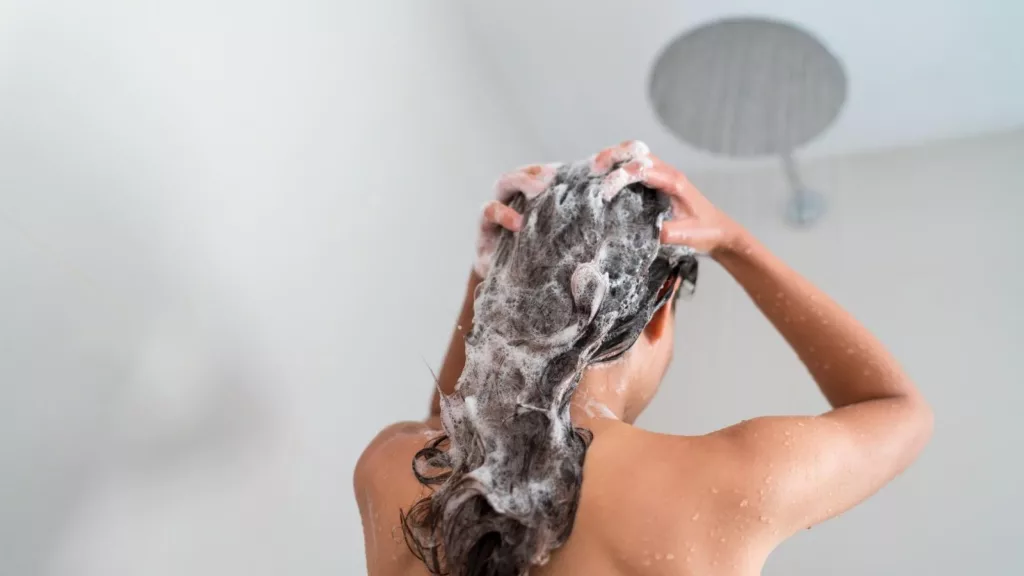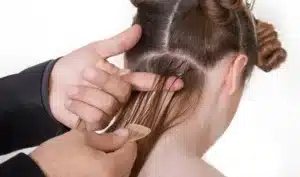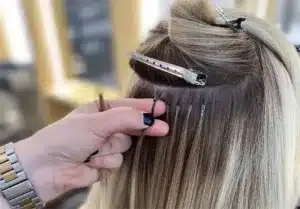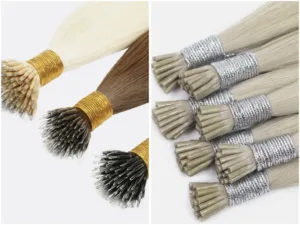Do your extensions feel rough, dull, or tangled after showers? Live in a city with stubborn limescale? Let’s talk hard water and why it quietly ruins expensive hair.
Yes—hard water affects hair extensions. Calcium and magnesium cling to fibers, cause dryness, color shift, buildup at bonds, and faster matting. You can prevent damage with chelating care, filtered water, smarter products, and a strict maintenance plan.

I work on the manufacturing and product side, so I watch hair performance across regions with different water profiles. Below is a clear, field-tested guide for salon owners, professional stylists, distributors, and clients who need reliable, repeatable results.
Does hard water affect hair extensions?
Clients often blame “bad hair.” In many cases, the water is the real problem. Minerals do not care about brand or method.
Hard water deposits calcium and magnesium on hair. This lifts cuticles, dulls color, accelerates tangles, and weakens adhesives and beads around bonds.
What “hard” water means
Hard water carries dissolved calcium and magnesium measured as grains per gallon (gpg) or ppm. 0–3 gpg is soft, 3–7 is moderately hard, 7–10.5 is hard, and 10.5+ is very hard. The higher the number, the more mineral film you will fight on hair fibers.
What minerals do to extensions
Extensions do not receive scalp sebum, so they rely on products for slip. When calcium and magnesium bind to the cuticle, they roughen the surface and block conditioners from working. Heat styling bakes this film onto the shaft. Color-treated blondes may shift warm or look “brassy.” Platinum tones can look yellow or greenish after copper exposure.
Attachment stress
Mineral film builds at the root zone. Tape adhesive can lose tack or lift at edges. Keratin bonds can chalk, get brittle, and snap under tension. Micro/nano rings accumulate grit inside the bead, which increases friction and local tangling. Sewn-in rows can collect scale along stitch lines and nape, where sweat and water sit longer.
Quick reference
| Hardness level | Typical effect on extensions | Risk level |
|---|---|---|
| 0–3 gpg (soft) | Normal slip, predictable care | Low |
| 3–7 gpg | Slight dullness over weeks | Medium |
| 7–10.5 gpg | Noticeable dryness, tangles, tone shift | High |
| 10.5+ gpg | Adhesive issues, severe matting risk | Very high |
How do you know if hard water is affecting your hair?
leading paragraph:
You see the signs in the mirror and on the shower hardware. The hair and the bathroom both tell the same story.
snippet paragraph:
Look for dullness, grabby mid-lengths, faster tangles, brassiness, stiff feel after drying, itchy buildup at bonds, and limescale on faucets and glass.
In-hair indicators
The hair feels rough even after conditioner. The brush snags halfway down the shaft. Blonde shades look yellow or orange quickly. Reds and coppers lose clarity. After blow-dry, the hair looks puffy but not bouncy. Ends feel dry yet coated, as if product is “sitting on top.”
Bond-area indicators
Tape tabs show edge lift earlier than expected. Keratin bonds feel gritty. Nano/micro rings trap white or chalky residue at the bead line. The nape mats sooner than the crown. Clients report itching near rows even with clean scalp habits.
Bathroom indicators
Shower glass shows white spots that do not wipe off easily. Faucets show crusty deposits. Kettles and humidifiers scale up fast. Laundry feels stiff. These are the same minerals landing on hair.

Simple tests and thresholds
Use hardness test strips or a pocket TDS meter. If strips read 7+ gpg or TDS > 200 ppm, build a stricter routine. Plan monthly chelation, a filter, and tighter move-up windows.
| Signal | What it suggests | Action |
|---|---|---|
| Persistent dullness | Mineral film blocking conditioner | Add chelating wash weekly–biweekly |
| Edge-lifting tapes | Calcium at adhesive line | Switch to distilled rinse days; retape with deep cleanse |
| Yellowing blondes | Iron/copper exposure | Use anti-brass chelator + violet/blue tone |
| Bead-line grit | Scale inside rings | Chelate rows; blow-dry roots thoroughly |
How to get hard water out of extensions?
You cannot “condition away” minerals. You must remove them, then rehydrate the fiber.
Use a chelating shampoo, then an acidic rinse, then deep condition. Protect bonds during the process. Finish with pH-balanced products and full drying at the root.
Step-by-step chelation day
1) Detangle dry hair with an extension-safe brush. Support bonds with your hand.
2) Pre-rinse with warm water to open buildup.
3) Apply a true chelating shampoo (look for EDTA, HEDTA, citric acid, phytic acid) to the scalp and mids. Work around bonds gently. Avoid scrubbing tapes or keratin points.
4) Let it sit 2–3 minutes on mids-to-ends. Rinse well.
5) Optional targeted acidic rinse: dissolve 1 teaspoon citric acid crystals in 500 ml warm water. Pour through mids-to-ends only. Leave 60 seconds. Rinse. (Avoid direct contact with adhesives.)
6) Apply a rich mask with amino acids and lightweight lipids to mids-to-ends. Process 5–10 minutes. Rinse cool.
7) Towel-blot. Apply a bond-safe leave-in and heat protectant.
8) Blow-dry roots fully to prevent moisture under bonds. Finish mids-to-ends on medium heat.
Frequency
Very hard water (10.5+ gpg): chelate weekly or every other week. Hard (7–10.5): every 2–3 weeks. Moderate (3–7): monthly. Always follow with moisture. Over-chelation without conditioning can make hair feel crispy.
Special notes by method
Tape-ins: keep chelators and acids away from the adhesive. Work below the tab.
Keratin bonds: do not soak bonds; rinse quickly.
Micro/nano rings: focus on bead-line cleansing and full drying.
Wefts and rows: lift rows with your fingers and flush water through underneath to remove trapped minerals.

Can a shower filter prevent hard water damage?
Filters help, but not all filters soften. Know the difference before you recommend one to clients.
Carbon and KDF filters reduce chlorine and some metals. Real softening needs ion-exchange or a whole-home softener. Maintenance timing decides success.
Filter categories
Carbon filters remove chlorine and improve smell and feel, which helps color hold and scalp comfort, but they do not remove calcium and magnesium effectively. KDF media can reduce some metals like iron and copper, which helps prevent green or brassy tones in blondes.
Softeners vs filters
True softening typically uses ion-exchange resin that swaps calcium and magnesium for sodium or potassium. Whole-home softeners deliver the best result for hair, skin, laundry, and appliances. Point-of-use shower “softeners” that actually soften are rare; most are filters labeled as softeners.
Replacement and performance
All systems need cartridge or resin changes. A clogged filter reduces pressure and does little for minerals. Set reminders. For clients in rentals, recommend a certified high-capacity shower filter plus distilled-water rinse days for extension care.
Practical pairing
Use: 1) a quality shower filter for chlorine/iron/copper, 2) chelating wash cadence, 3) a final distilled-water rinse on install and color days. If family budget allows, a whole-home softener provides the most reliable protection for premium extensions.
| Solution | What it does | Limitations |
|---|---|---|
| Carbon/KDF shower filter | Cuts chlorine, some metals | Little impact on calcium/magnesium |
| Ion-exchange softener | Softens water | Installation and salt maintenance |
| RO system | Purifies water | Not practical for whole showers |
| Distilled rinse | Zero minerals on key days | Extra step; cost over time |

Which extension types are most sensitive to hard water?
All methods suffer in very hard water, but some fail faster. The bond chemistry matters.
Tape-in adhesives and keratin tips react fastest. Micro/nano rings accumulate grit. Sewn-in rows collect scale at the nape. Halos and clip-ins are easiest to rescue.
Sensitivity overview
Tape-ins rely on clean, low-mineral surfaces to keep tack. Calcium at the tab edge causes micro-lift and water wicking. Keratin fusion bonds can chalk from mineral contact, then crack under ponytail tension. Beaded methods do not dissolve, but beads trap grit; friction rises and causes tangles at the root line. Weft rows themselves do not fail, yet the stitch path and nape hold moisture and scale, which leads to matting if drying is poor.
Practical ranking (most to least sensitive)
1) Tape-ins (adhesive edge lift, residue)
2) Keratin bonds (chalk, brittleness)
3) Micro/nano rings (grit, friction, tangles)
4) Sewn-in rows (scale along stitch lines, nape matting)
5) Clip-ins/Halo (no bond failure, easy basin chelation)
What to change
For tape/keratin clients in 10.5+ gpg markets, shorten move-up windows, add distilled rinse on install day, and use a stricter chelation plan. For beaded and sewn-in clients, focus on root-zone cleansing and complete drying under rows.
| Method | Main risk from hard water | Best counter |
|---|---|---|
| Tape-ins | Edge lift, residue | Distilled rinse + adhesive-safe chelation |
| Keratin | Chalk, cracking | Moisture balance + careful chelation |
| Micro/Nano | Grit at beads | Root-zone cleanse + full drying |
| Sewn-in | Nape matting | Detangle protocol + chelation cadence |
| Clip/Halo | Dullness | Basin chelate + deep condition |

What products and ingredients help in hard water—and what should I avoid?
Ingredients matter more than marketing. Read the INCI list like a pro.
Use chelators (EDTA, citric/phytic acid), gentle cleansers, amino-rich masks, heat protectants. Avoid heavy oils on roots, sticky silicones at bonds, and high-alkaline shampoos.
Use list
Chelating shampoos with EDTA/HEDTA remove calcium and magnesium. Clarifiers with phytic or citric acid help lift metal ions. Follow with a conditioner rich in amino acids (arginine, serine) and lightweight emollients (squalane, meadowfoam) that hydrate without smothering bonds. A thermal protectant reduces porosity spikes during heat styling, which slows future mineral attachment.
Caution list
Heavy oils and butters at the root line migrate into tapes, soften keratin, and lubricate beads. Thick, non-evaporating silicones can combine with minerals and create a varnish-like film. High-pH cleansers push the cuticle open; minerals stick more.
Example routine
Chelate as scheduled, then condition mids-to-ends only. Use a bond-safe leave-in. Apply a light serum only on the very ends. Always dry the root zone completely. Rebalance with a protein-light moisture mask if hair feels squeaky after chelation.
| Category | Look for | Avoid |
|---|---|---|
| Cleansers | EDTA/HEDTA, citric acid | Harsh sulfates if hair is fragile |
| Conditioners | Amino acids, lightweight lipids | Heavy oils near bonds |
| Stylers | Heat protectant, light silicones | Sticky resins at root |
| Treatments | Chelator monthly/biweekly | Over-clarifying without moisture |
How to test water and build a hard-water care plan?
Guessing wastes time and money. Test once and set a plan.
Use hardness strips or a TDS meter. Map gpg to care frequency, then schedule chelation, product rules, and move-up timing in advance.
Testing tools
Hardness strips give a quick gpg number. A handheld TDS meter shows total dissolved solids in ppm. Neither replaces a lab, but both guide salon policy. Test the salon’s water and ask clients about home water. If they commute between homes, plan for the worse value.
Planning by hardness
0–3 gpg: standard care, monthly chelation.
3–7 gpg: chelate every 3–4 weeks, strict product rules at roots.
7–10.5 gpg: biweekly chelation, distilled rinse on install/color days, shorten move-up windows.
10.5+ gpg: weekly chelation, shower filter, distilled rinses, strict drying protocol, tighter maintenance.
Salon system
Create a hard-water note on the client record. Pre-book chelation visits with move-ups. For tapes/keratin, include a distilled-water station in the backbar on install days. Train assistants to dry the root zone first and lift rows to move air through stitch lines.
| Hardness | Chelation | Special steps |
|---|---|---|
| 0–3 gpg | Monthly | Normal care |
| 3–7 gpg | 3–4 weeks | Root product discipline |
| 7–10.5 gpg | 2 weeks | Distilled rinse on service days |
| 10.5+ gpg | Weekly | Filter + tight move-ups |
My opinion
From a manufacturing perspective, premium full cuticle, single-donor hair tolerates hard water better because the cuticle remains intact and seals more predictably after chelation. Nonremy hair with mixed cuticles grabs minerals faster and tangles sooner. Even the best hair fails without a plan in very hard water. Test once, document hardness, then build service cadence and product rules into every client file.

FAQ
Q: Does hard water permanently ruin extensions?
A: No. Mineral buildup is removable with chelation and proper conditioning. Long neglect can dry fibers and shorten lifespan, but early action restores slip and shine.
Q: How often should clients in hard-water cities chelate?
A: At 7–10.5 gpg, plan every 2 weeks. At 10.5+ gpg, weekly. Always follow with a deep conditioner and full root drying.
Q: Can I chelate tape-ins?
A: Yes, but keep chelators away from adhesives. Work mids-to-ends. Use distilled rinse on install day to minimize residue near tabs.
Q: Why do blondes turn brassy or green?
A: Iron drives orange/yellow warmth; copper drives green. Use a metal-removing chelator and then tone with appropriate blue/violet formulas.
Q: Do leave-in oils protect against hard water?
A: Oils at the root can cause slippage and trap grit. Keep oils on the last few inches only.
Q: Is a shower filter enough without a softener?
A: Filters help with chlorine and metals. They do not fully remove calcium/magnesium. Pair with chelation and, if possible, a softener.
Q: My nano/micro rings feel gritty—what now?
A: Schedule a root-zone cleanse and chelation, dry bonds fully, and review product use at the scalp. Replace any strands that rotated or slipped.
Q: Can I use apple cider vinegar instead of a chelator?
A: A mild acid rinse can help, but it is not as effective as a true chelating shampoo. Use ACV as a supplement, not a substitute.
Q: Will distilled water rinses make a big difference?
A: Yes, especially on install and color days. Distilled has zero minerals, so it prevents new deposits while you reset the fiber.
Q: Which method should I recommend in very hard water?
A: Methods without adhesive (beaded, sewn-in) avoid glue issues, but all methods still need chelation and strict drying. Choose based on hair health and lifestyle.
Conclusion
Hard water is manageable. Test your water, set chelation and product rules, dry roots completely, and plan maintenance. With the right system, premium extensions stay soft, glossy, and secure.




